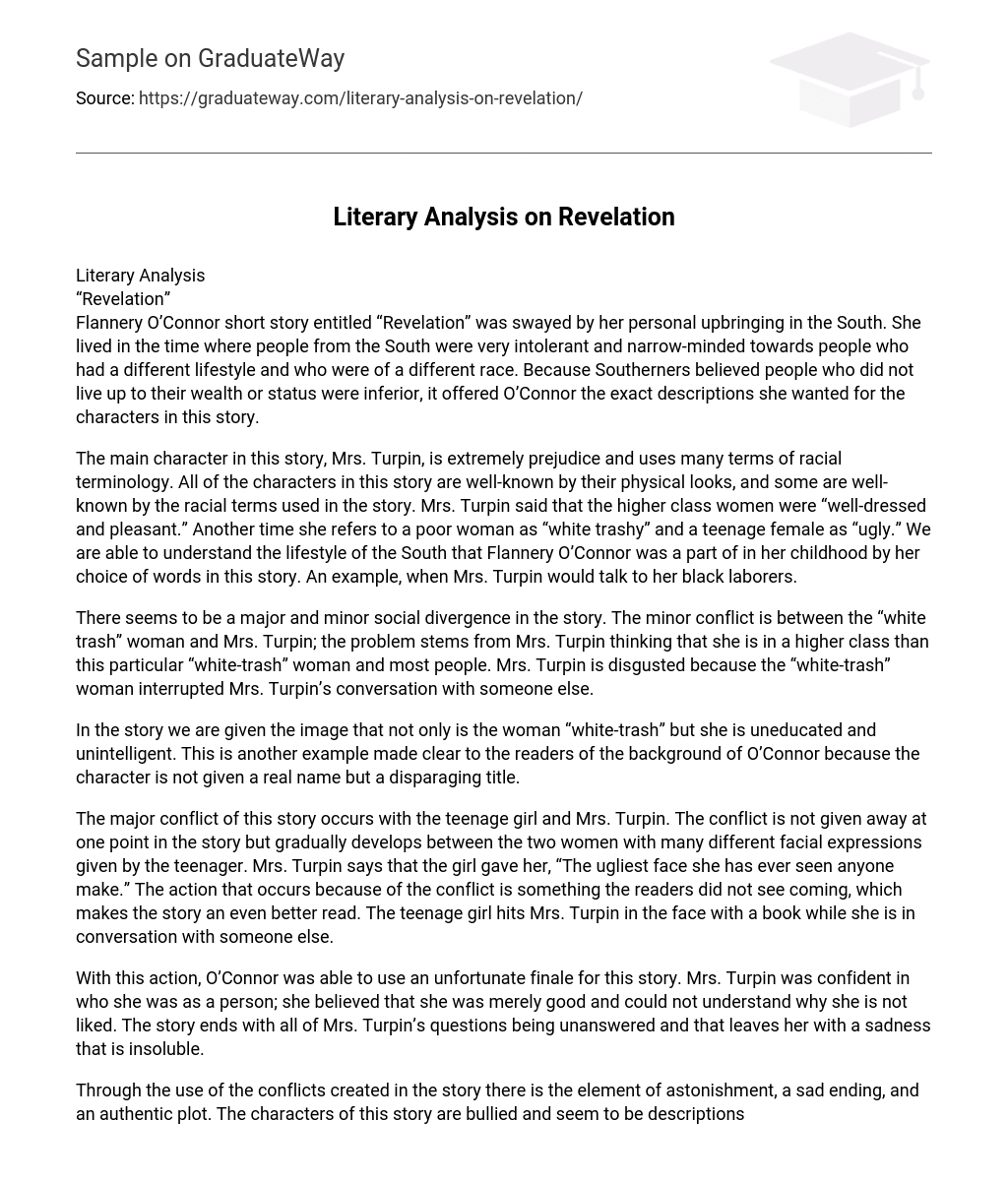Literary Analysis
Revelation”
Flannery O’Connor’s short story entitled “Revelation” was influenced by her personal upbringing in the South. She lived in a time when people from the South were very intolerant and narrow-minded towards those who had a different lifestyle or were of a different race. Southerners believed that people who did not live up to their wealth or status were inferior, which provided O’Connor with the exact descriptions she wanted for the characters in this story.
The main character in this story, Mrs. Turpin, is extremely prejudiced and uses many terms of racial terminology. All of the characters in this story are well-known for their physical appearance, and some are identified by the racial terms used in the story. Mrs. Turpin stated that the higher-class women were “well-dressed and pleasant.” On another occasion, she referred to a poor woman as “white trashy” and a teenage female as “ugly.” By her choice of words in this story, we are able to understand the lifestyle of the South that Flannery O’Connor experienced during her childhood, such as when Mrs. Turpin would talk to her black laborers.
There seems to be a major and minor social divergence in the story. The minor conflict is between the white trash” woman and Mrs. Turpin. The problem stems from Mrs. Turpin thinking that she is in a higher class than this particular “white-trash” woman and most people. Mrs. Turpin is disgusted because the “white-trash” woman interrupted her conversation with someone else.
In the story, we are given the image that not only is the woman white-trash,” but she is also uneducated and unintelligent. This is another example made clear to the readers of the background of O’Connor because the character is not given a real name but a disparaging title.
The major conflict of this story occurs between the teenage girl and Mrs. Turpin. The conflict is not revealed at one point in the story, but gradually develops between the two women, with the teenager displaying many different facial expressions. Mrs. Turpin says that the girl gave her the ugliest face she has ever seen anyone make.” The action that occurs because of the conflict is something the readers did not see coming, which makes the story an even better read. The teenage girl hits Mrs. Turpin in the face with a book while she is in conversation with someone else.
With this action, O’Connor was able to use an unfortunate finale for this story. Mrs. Turpin was confident in who she was as a person; she believed that she was merely good and could not understand why she was not liked. The story ends with all of Mrs. Turpin’s questions being unanswered, and that leaves her with a sadness that is insoluble.
Through the use of conflicts created in the story, there is an element of astonishment, a sad ending, and an authentic plot. The characters in this story are bullied and appear to have lower intellect. In contrast, Mrs. Turpin is supposed to be of common intellect. The conduct of Mrs. Turpin really emulates the image O’Connor was given in the South. Mrs. Turpin is a very nice individual, extremely sociable, and observes the people around her, starting conversations with anyone who will listen.
Another characteristic of Mrs. Turpin is her plausibility. She seems to be this way because her actions exemplify a believable person. O’Connor makes Mrs. Turpin the exact model of a Southern Citizen” with the same attitude as a Southerner.
O’Connor did a great job of using many literary devices, mainly symbolism, which helped her emphasize the theme of this story. Mrs. Turpin is extremely disliked by the teenager from the beginning of the story all the way to the end. The teenager’s dislike for Mrs. Turpin propagates as the story continues and then seems to explode at the end, resulting in the action of hitting Mrs. Turpin.
The book being thrown at Mrs. Turpin possibly symbolizes the distinctive types of social classes. The well-dressed woman Mrs. Turpin converses with is an educated and high-standard individual, while the white-trash” woman is an uneducated and low-class individual.
Another literary device used in this story is foreshadowing. Foreshadowing was seen by the teenage girl making facial expressions towards Mrs. Turpin. These actions showed a struggle between the two women. As the story continues, the increase of these disrespectful actions foreshadows a disagreement between Mrs. Turpin and the teenager. In conclusion, foreshadowing, as well as symbolism, is the most important literary device used by Flannery O’Connor in “Revelation.”





